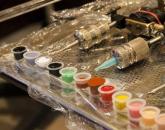Shoe store equipment. Visual merchandising Design of a shoe store taking into account the age and gender of customers
How to update the design of the store without a big budget? - this is the question that customers, owners of small chains or single stores often turn to visual merchandisers.
Linda Cahan, an American visual merchandising specialist, answers this topic very concisely and specifically on The Mannequin Madness. We bring to your attention an abridged translation.
1. Tidy up
It works better than anything else if you want to enhance the attraction, vibe and atmosphere of the store. This does not mean that if your store's merchandising is flea market style, you should switch to museum geometry. You just need to get rid of the excess - on the floor, behind the cash register, in the corners and aisles, put the warehouse in order so that you can easily find what you need. Start cleaning one area per week until you've cleaned the entire store. You will immediately feel fresh and new.
2. Focus on focal areas
If you don't have the ability to redo the entire store, focus on the areas that the customer notices first. Conduct a survey among your staff, customers, relatives and acquaintances - what exactly are these zones and whether these are the zones that you yourself think about. Display them with bright products using the principle of color stories, add color and graphics. Last but not least, increase the illumination of each such zone!
Do you want to order window dressing for a shoe store? Contact us!
Every day, a modern person makes a choice in favor of one thing or another. It is the choice that the buyer has that makes sellers think more about the components of retail spaces. Customer loyalty in our time is a fundamental factor in successful trading.
Consider the components of a shoe store that is in demand.
The shoe store sells models according to the tastes of its target audience. It is the correct definition of your audience that helps to understand what to buy, in what quantity, what color.

Shoes- this is a product that requires the obligatory presence of a sales assistant nearby, the store staff is simply obliged to know comprehensive information about the product and its care.
Creating the right atmosphere in the store is carried out due to the interior, in which commercial equipment is competently designed, enough space is allocated for fitting rooms, and the showcases reflect the theme of the store.




The assortment of a shoe store changes from season to season, the layout also changes, but the atmosphere must remain so that the new buyer feels that he has come to where he will find what he wants.
It is in the shoe sector that designers are increasingly playing with the form of display equipment, sometimes the form is so closely intertwined with the overall interior that it is impossible to imagine such equipment anywhere else.



It is also necessary to take into account the change in assortment when designing, to provide for the transformation of elements; with successfully designed equipment, the store will change from season to season.
When designing shop windows, it is important to consider the connection between the exterior design and the interior. Also, we must not forget that the showcase primarily informs about the product, if we talk about selling showcases. That is why the main thing in the showcase is to make the right emphasis on the product, while the decor is left behind, then your buyer will see that very pair of shoes...
We provide services for the design of shoe stores, the creation of unique trade and demonstration equipment, window dressing for shoe stores.
Turning to us, you get a store that will meet the needs of your target audience, and the design of the shoe store window will correspond to the brand ideology or the theme of the store


20.03.2013 28948
It is unlikely that anyone will argue with the fact that sales depend on the competent display of goods in the hall. And if your sales don't seem strong enough to you, maybe a little rearrangement will help. Nina Zaslavskaya, an expert and business coach in the field of visual merchandising, talks about the basic principles of arranging shoes on the trading floor, their advantages and disadvantages.
Do not neglect the principles of assortment presentation in a shoe store: by applying them correctly, you can influence the behavior of the buyer and lead him in the right direction, or, conversely, distract attention and create conditions for a spontaneous purchase.
It should be said right away that the principles described in this article are applicable only to stores with price positioning in the economic and middle segments. Luxury stores, as well as those who work according to the scheme “all stock is in the hall, the goods are taken out of the warehouse”, are guided by slightly different rules worthy of a separate material.
There are at least four main ways of arranging shoes on the trading floor: by brand, by size, by collection, and by category. All of these principles have their own characteristics and shortcomings, which should be taken into account in each specific case.
Breakdown by brand. Owners of multi-brand shoe stores often believe that “their brands are well known to everyone”, therefore they mistakenly believe that arranging shoes by brand will help the buyer navigate the product. In fact, shoe brands that are really well known to most Russian buyers can be counted on the fingers, and they are usually sold only in the brand's branded stores. Most of the brands of the economic and middle segment are known only to professional shoemakers, and they are most likely sold in your store.
If you are not sure that your brands are on the top list of the most recognizable in Russia, do not risk using branding. Otherwise, the store will not benefit in sales from the use of such a calculation: the buyer will simply ignore your concept, and his search for the product will be chaotic.
Use brand placement if your store has at least one brand with a high level of recognition in the assortment, and you know for sure that it will attract a buyer. Make this brand stand out as a separate brand corner by decorating it with branded POS materials. The equipment for such a corner may differ from the main equipment of the store, which will make it possible to mark the brand area against the general background, thus creating a kind of "shop-in-shop" (shop-in-shop).
Sizing was common under socialism, and today can be used in economy format stores and discounters that sell leftovers or incomplete size grids. For the seller, the principle of sizing is useful because it allows you to mask the lack of sizes in individual models, and it is convenient for the buyer because it saves his time. The client, having entered the store, immediately approaches the equipment with his size, and he does not need the help of the seller to find the size in the warehouse. The disadvantage of this method is that if the customer has a “floating size”, or the exact size of the model is not known, he will have to walk between the two racks in search of the right product. This can make the customer feel annoyed and feel like a waste of time.
The layout by size signals to the buyer that the price of this product is low. Therefore, it is recommended to use it either during a sale, or in a store that does not have image claims. In addition, the sizing method is only suitable for large area trading floors, since in fact it is a somewhat modified concept of “all stock in the floor”. When planning a store this way, it is very important that the size navigation is clearly visible from the entrance. As for the division within the dimensional zones, it is desirable to group shoes in them according to the principle of “like with like”.
Arrangement by collections. From the point of view of the buyer, the concept of "collection" in the shoe industry is very arbitrary, because in the generally accepted sense, a collection is a set of models that make up an ensemble, that is, they can be worn together. The concept of an ensemble is not applicable to shoes, because a person cannot put one foot in a boot, and the other in a shoe with a heel. Therefore, in the field of footwear, a collection is understood as a set of articles (styles) united by one color scheme and the materials from which they are made.
Arrangement by collections in a shoe store is carried out with the help of additional accessories: bags, scarves, belts, gloves and other goods. This display principle will be useful in a store where sales of additional accessories make up a significant share, which is typical for outlets of the middle and medium-high segment. Shoppers at this level of shoe stores are usually wealthy enough to buy a pair of shoes and a bag with one check. In addition, arranging by collections in a shoe store orients the buyer to a spontaneous choice, since it does not help him in any way to make a targeted purchase. That is why this method will not be effective in stores in the "medium-low" or "economy" segments, in which people come to meet a specific need, and not "for a good mood."
When arranging shoes in collections, it should be noted that accessories must match in color and style with the shoes next to which they are placed. Otherwise, it will no longer be a collection, and the meaning of such a grouping of goods completely disappears. In addition, you should not abuse the number of bags, otherwise the shoes will simply be lost against the background of these larger accessories.
Arranging shoes by category- the best way to satisfy the specific desire of the client, because the product category is what the buyer came to the store for. For example, a customer might search for “prom heels,” “ballet flats to pair with jeans,” “magazine-style ankle boots,” “replacement boots that get wet” or “children's shoes for school.” All these are specifically formulated desires of the buyer, which the seller must satisfy. And arranging shoes by category is the best assistant in this matter.
To apply the category layout, you need to determine which product categories your assortment is divided into. In stores with a wide assortment, this division can be quite detailed, for example, not just “shoes” are distinguished, but “stilettos”, “wedge shoes” and “low-heeled shoes”. In stores with a narrower assortment, it is enough to divide the goods into the categories “boots”, “shoes”, “sports shoes” and others.
Place products from more popular categories in the best places, send models that have just been introduced into the assortment there. This will allow you to see how buyers react to the novelty. In the layout of goods by category, the use of cross-merchandising methods is also welcome, that is, the addition of shoes on the shelves with bags and accessories.
It is unlikely that anyone will argue with the fact that sales depend on the competent display of goods in the hall. And if your sales don't seem strong enough to you, maybe a little rearrangement will help. Expert and...
There are many different ways to create a beautiful storefront. And no matter what kind of decorations are used: bright and defiant, or, conversely, restrained and concise, they all invariably attract the eyes of buyers. To achieve a stunning effect will allow the use of photo printing. This popular type of decoration consists in applying various images to glass, mirror, wood, MDF. Through photo printing, you can effectively decorate display walls, ceilings, all kinds of niches and partitions. In addition to photo printing, the following techniques are widely used:
- painting on glass;
- sandblasting;
- matting;
- film stained-glass windows;
- stained-glass windows;
- fusing .
Rice. 1. A well-designed storefront can be both beautiful and casual at the same time.
Using them in the design, you can create a beautiful showcase for a shoe store, and, if necessary, visually divide the display space. Another way of zoning the area is to use all kinds of partitions. Our company offers high-quality and durable partitions, as you can see by reading .
With the help of stained glass techniques, you can decorate the windows of a wide variety of stores. You can verify this by referring to visual images and links to a convenient menu:
window dressing
By Application
How to design beautiful showcases for shoe stores
The most important thing for a selling showcase is to stand out from the crowd and arouse the interest of a potential buyer. What should you pay attention to, and what techniques, on the contrary, should not be used when creating beautiful showcases for shoe stores? Here is a blitz review of tips from some designers. So what to do:
- be sure to group products depending on gender, age, hobbies and even the social status of buyers;
- use extraordinary tricks: for example, make a deaf, but Ia bright showcase that completely closes the view to the store and thereby arouses the curiosity of customers;

Rice. 2. This shockingly bright and extraordinary installation
shoe salon can be safely called beautiful
- remember that the shoes displayed in the window should be the center of attention of the buyer; in highly specialized shoe stores, try to place advertising models in the very center of the window;
- apply in showcasex the so-called "living" structures, because the movement perfectly attracts attention; you can use both simple blowers and expensive interactive toys;

Rice. 3. Whether this shop window is beautiful or not, it draws attention to shoes
So, for several days, Parisians could control the movements of ballerinas dancing on a huge interactive screen with a wave of their hand. This screen was installed in the window of the dance shoe store Repetto and attracted a huge influx of customers.
- lure customers with lighting: well-thought-out light can make a shop window beautiful without additional decorations;
- if your shop window is facing a busy street, it should be brightly decorated to stand out from other shops and catch the eye of passers-by m.
Rice. 4. The futuristic design of the shop windows and the store front makes it possible to call
its design is beautiful and eye-catching
What not to do:
- in no case do not put in the window old shoes that have long gone out of fashion or according to the principle “what is not a pity”;
- do not place the product out of the view of customers, for example, on the floor of a very low display case;
- do not display shoes randomly, keep some order;
- remember that you are selling shoes, not window decorations;
- do not make an avant-garde showcase for a store offering classic shoes;
- do not decorate the window of a store selling shoes in the middle price segment with expensive decorations - a richly decorated window will simply scare off potential buyers; and vice versa: if you sell expensive branded shoes, decorate the window with taste and scope, otherwise customers may get the impression that you are selling in China and fake.

Rice. 4. Laconism in the design of this showcase creates the impression of exclusivity of goods
Fantasize and turn your fantasies into reality together with the decorators of our studio, thanks to which the atmosphere of a holiday and anticipation of new purchases will settle in your shop window. If you wish, you can find out offered by our company.
Beautiful showcases for a shoe store from our studio
Having extensive experience behind them, the masters of our studio will produce for you a high-quality and beautiful showcase for a shoe store in a short time. We will take into account all your wishes at the stage of creating a sketch, provide a full estimate of the work and perform the installation of the product at a convenient time for you.
Popular
- Confectionery business plan with calculations - how to open a confectionery business plan for a home confectionery sample with calculations
- Business plan for a tire shop What you need for a truck tire fitting
- How to open a taxi service: the nuances of doing business
- The most promising business ideas from America
- How to open a .DSF file? How to open DSF? Sponsor Information
- Features of the presentation of tourism services on the example of the travel agency "Hot Tours" (g
- Ideas for starting a business in the USA Idea #1
- Urgent order of a gazelle cargo taxi24
- How much does a YouTube channel earn?
- Features and organization of the case




